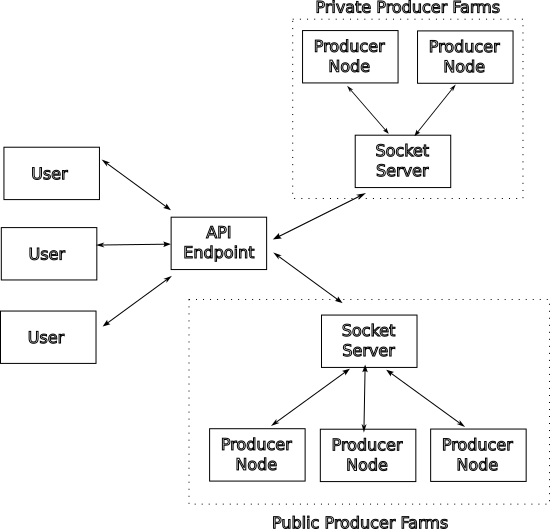How It Works¶

PriVox Voice Exchange System Overview¶
Overview¶
Central to the Privox voice exchange is the notion of a producer farm. A producer farm is a publicly available endpoint which socket consumers and producers can connect to. It acts as an anonymous directory connecting producers with consumers in a pseudo random manner.
The API servers will take an inbound request and select a producer farm to deliver the request to. The producer farm will decide which producer node to forward the request to. Neither endpoint knows anything about the other.
Privox maintains a set of Privox controlled producer farms and associated static producer nodes, but most producer farms are user contributed as are most producer nodes.
When a request is received by an API server (api.privox.io/stt for example), it selects a user powered producer farm and sends it the request. If that fails it will try a second and if that fails, it will fallback to an organizational producer farm.
Currently the producer farm work distribution strategy is simply to spin thru the list of available producer nodes in an array which is organized by time connected and forward the request to the first idle connection found. Obviously this can be improved upon in the future as may the API server farm selection strategy.
Detail¶
Currently, all producer nodes are pull producer nodes. This means they connect to a producer farm and wait for requests. Pull producer nodes adhere to the Privox pull node protocol which is a very simple fixed length header followed by a more specific command. See the repository under the ‘farm/’ directory for the code that pushes the requests and see the ‘producer/’ directory for the code that services those requests.
API CGI Code¶
The API CGI code may be found under the ‘api/cgi/’ directory. This code selects the producer farm and handles associated retry logic. The APIs are standard python CGI scripts which are designed to be run by an Apache or nginx webserver, though they are easily adaptable to other servers like flask or lighthttpd.
The main stt.py (tts.py is very similar) code looks like this …
Python
1while retry_ctr > 0 and result != '':
2 stt_cgi.transcriber.farm = get_producer_farm()
3 stt_cgi.transcribe()
4 result = stt_cgi.transcriber.err_msg
5 bark("stt retrys left = %s, result = %s" % (retry_ctr, result))
6 retry_ctr -= 1
The get_producer_farm() method tries to select a random farm from the current directory of farms.
Python
1PRODUCER_FARMS = ['pfalpha', 'pfbeta']
2
3def get_producer_farm():
4 max_val = len(PRODUCER_FARMS)
5 rnd_val = int( random.random() * 100 ) % max_val
6 return PRODUCER_FARMS[rnd_val] + ".privox.io"
The following files may be found under the ‘api/cgi/’ directory of the repository.
cgi_config.py - configuration values
cgi_util.py - utility functions
stt.py - main http entry point, selects producer farm
stt_cgi.py - cgi form validator
stt_remote_transcriber.py - sends request to producer farm
tts.py - main http entry point, selects producer farm
tts_cgi.py - cgi form validator
tts_remote_transcriber.py - sends request to producer farm
Producer Farm Code¶
The producer farm code may be found under the ‘farm/’ directory. The producer farm is a simple socket server. It takes either ‘tts’ or ‘stt’ on the command line which means the same server base code is used for both. The server launches a consumer socket or producer socket based on the response to the ‘who’ field in the initial socket bring up sequence.
privox_config.py - configuration values
privox_utils.py - utility functions
privox_socket_server.py - pass ‘tts’ or ‘stt’ on command line
stt_socket_consumer.py - socket handler for stt consumers
stt_socket_producer.py - socket handler for stt producers
tts_socket_consumer.py - socket handler for tts consumers
tts_socket_producer.py - socket handler for tts producers
Producer Node Code¶
The producer node code is the code which runs on a contributor’s machine. It may be found in the ‘producer/’ directory of the repository.
install.sh - install script installs both tts and stt on your machine
prime.sh - loads all models for tts and stt
start.sh - runs a tts and stt node
stt_producer_socket.py - stt producer node
tts_producer_socket.py - tts producer node